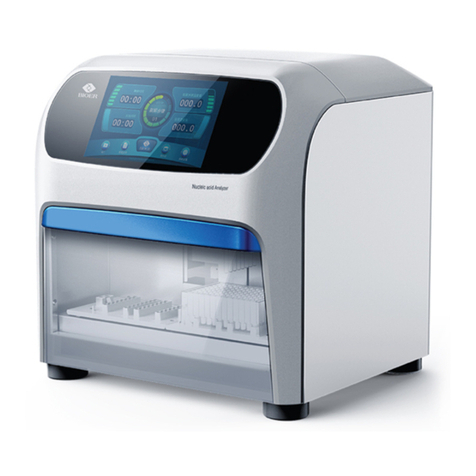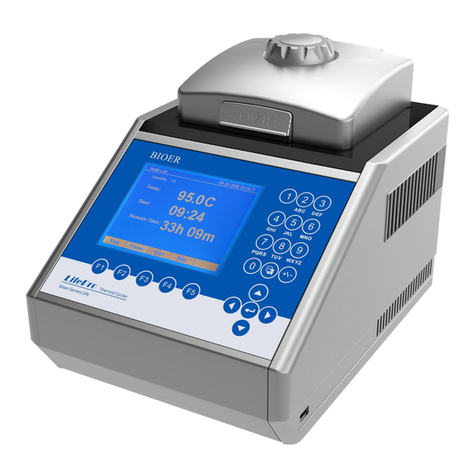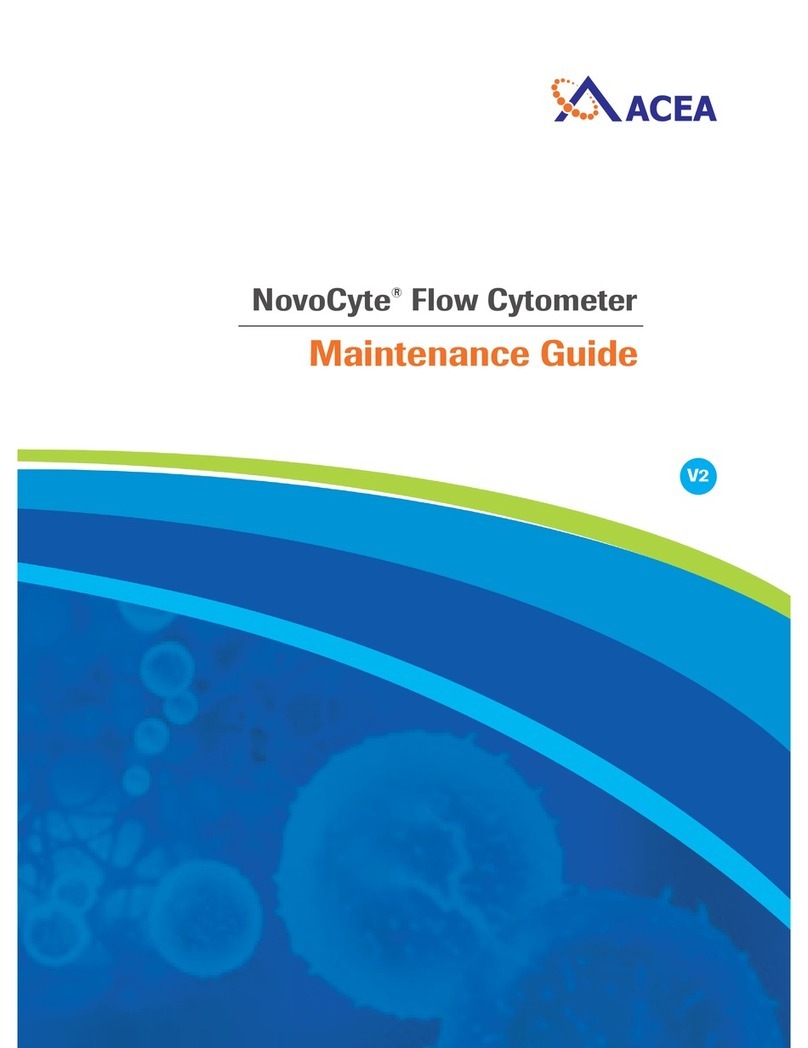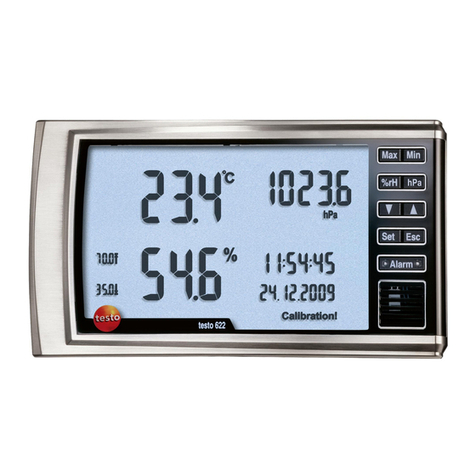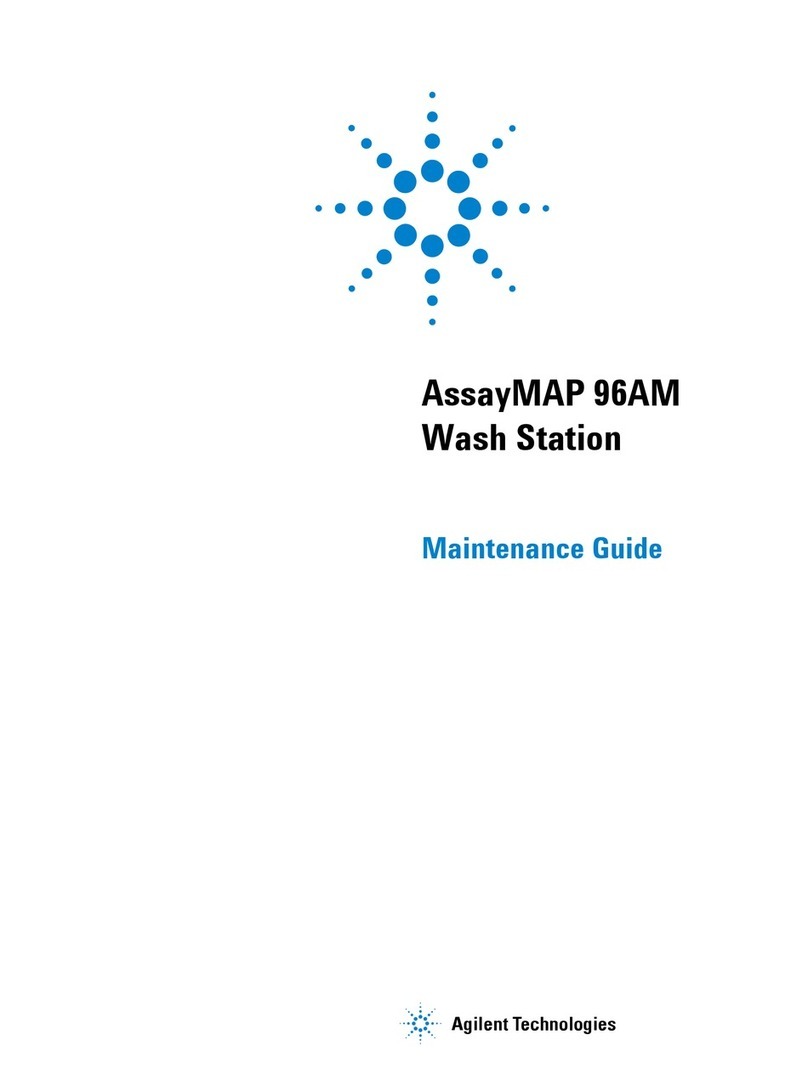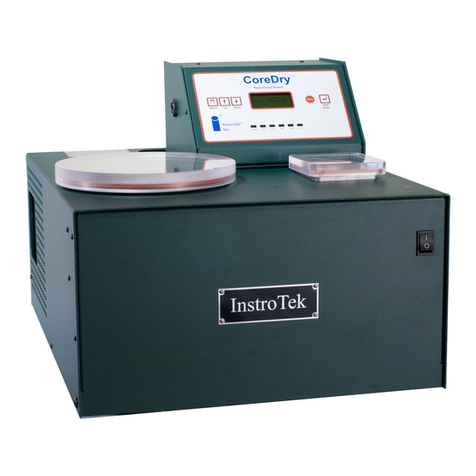Bioer GeneQ Thermal Cycler User manual

Note: The Bioer Co. reserves the right to modify this manual at any time without
notice.
Patent materials are included in this manual. All rights reserved. No part of this manual shall be
photocopied, reproduced, or translated into other languages, without written permission from the
Bioer Co.
Patent No.:ZL 98 2 44367.6
Standard No.:YZB/ 0189 - 2008
Document Number: BYQ60410000000ESM
Document Version: FebruaryAprilJan,2009 20114 Version 2.01.68
Please read this manual carefully before the Thermal Cycler is first
operated !

Gene Q Thermal Cycler Important Note
―I―
Important Note
1 CONVENTIONS
Note:
Because of the important information in this column, please read it carefully.
Failure to follow the advice in this column will possibly result in damage or
malfunctioning of the Thermal Cycler.
Warning!
This symbol means that you should be cautious to take an
operation/procedure. Failure to follow the requirements in this column will
possibly result in personal injury.
2 SAFETY
During the operation, maintenance, or repair of the Thermal Cycler, the following safety measures
should be taken. Otherwise, the guard provided by the Thermal Cycler is likely to be damaged, the
rated safety level to be reduced, and the rated operation conditions to be affected.
The Bioer Co. shall not be in any way responsible for the consequences resulted from buyer’s not
observing the following requirements.
Note:
The Thermal Cycler, complying with the National Standard EN61010-2-010 :
2003 & EN61326-1 : 2006, is a general instrument of classⅠ, the protection
degree is IP20. It is intended for indoor use.
a) Grounding Considerations
A.C. power’s grounding should be reliable for fear of an electric shock. The 3-pin plug with the
Thermal Cycler’s power line is a safety device that should be matched with a grounded socket.
Never let the third ground pin floating. If the 3-pin plug cannot be inserted, it is recommended to ask
an electrician to install an appropriate power socket.
b) Keep Away from Electric Circuits
The operator is not allowed to open the Thermal Cycler. Changing components or adjusting certain
parameters inside the device must only be accomplished by the certificated professional
maintenance personnel. Do not change elements while the power is still on.
c) A.C. Power Considerations
Before turn on the power, always check if the mains voltage is within the required ~220-240V(or
~100-120V) and if the current rating of the power socket meet the required specification, i.e. 200W.
d) A.C. Power Line Considerations
As an accessory of the Thermal Cycler, the A.C. power line should be a default one. If it is damaged,
the A.C. power line may not be repaired, but it must be replaced with a new one. The power line
should be free of heavy objects during the Thermal Cycler’s operation. Keep the power line away
from the place where people gather regularly.
e) Connect the A.C. Power Line
While connect or disconnect the power line, you should hold the 3-pin plug with your hand. Insert
the plug thoroughly to ensure good contact between the plug and socket. Pull the plug, not the line,
when you need to disconnect to the mains.

Gene Q Thermal Cycler Important Note
―II―
f) Design Environments
The Thermal Cycler should be placed in a low-humidity, dust-free, and good-ventilation room
without caustic gas or powerful magnetic interference. In addition, water sources, such as pools
and water pipes, should be separated a distance from the Thermal Cycler.
Never cover or obstruct the openings of the Thermal Cycler, which are designed for ventilation and
to prevent the device’s interior from being too hot. When a single device is running, the shortest
distance between its openings and the nearest object is 50cm; otherwise, when two devices or
above are running at the same time, the shortest distance is 100 cm. Do not place the device on a
soft surface, because that will result in adverse ventilation near the device’s bottom openings.
Too high temperature will lead to degraded performance or failure of the Thermal Cycler. Therefore,
the device should be protected against any kind of heat sources like sunlight, ovens, or central
heating equipment.
If the Thermal Cycler is set aside for a long time, it is recommended to disconnect the power line to
mains and cover the device with a piece of soft cloth or plastic to prevent dust from entering.
Note:
Once one of the following events occurs, you are suggested to disconnect the
power line with mains, and contact the distributor or ask a certificated
maintenance worker for help.
Liquid into the device;
The device sprinkled or drenched;
The device malfunctioning, giving off abnormal sound or odor;
The device falling onto the floor or its shell damaged;
Significant changes in the device’s performance.
3 EMC Consideration
Note:
This is a class A equipment, only suitable for use in establishments other than
domestic, and those directly connected to a low voltage power supply network
which supplies buildings used for domestic purpose.
4 Protection Degree: IP 20
5 LABELS
a) Tablet
BIOER TECHNOLOGY CO., LTD.
Name: Thermal Cycler Model:TC-**/H(b)
Power:~220-240V 200W 50/60Hz
Fuse: 250V 2.5A(Φ5×20) Sort: classⅠIP20
SN: BYQ*****-*** Date: ****.**

Gene Q Thermal Cycler Important Note
―III―
HANGZHOU BIOER TECHNOLOGY CO., LTD.
Name: GeneQ Thermal Cycler
Model:TC-**/H(b)
Power: 100-120V~50/60Hz 200W
Fuse: 125V 5A(Φ5×20) Sort: classⅠIP20
SN: BYQ*****-***
Date: ****.** Made in China
b) Warning Sign
Warning!
There are two warning signs read ‘HOT SURFACE !’. The metal part near those
signs (on the block and hotlid) is not allowed to be touched by any part of the
body for fear of the body burn, during the program execution and in the short
period after the program execution!
6 MAINTENANCE
The conical holes over the block should be cleaned regularly with soaked cotton swab. That
ensures sufficient contact and thus good heat conduction between each conical hole and the tube
inside it.
In case it is smeared, the surface of the Thermal Cycler may be scrubbed with a piece of
dehydrated soft wet cloth.
7 WARRANTY AND SERVICE INFORMATION
a) Warranty
The Thermal Cycler is warranted for a period of one month, from date of shipment from the
company, to be free from defects in material and workmanship. The Bioer Co. shall be obligated,
under this warranty, to exchange the Thermal Cycler which proves to be defective as described
herein.
The Thermal Cycler is also warranted for a period of eighteen months, from date of shipment from
the company, to be free from defects in material and workmanship. The Bioer Co.’s obligation under
this warranty shall be limited to repair or exchange (at the Bioer Co.’s option) of the Thermal Cycler
Warning! During surface cleaning, the power must be off.
Corrosive scour is not allowed to clean the surface.

Gene Q Thermal Cycler Important Note
―IV―
which proves to be defective as described herein.
The buyer is responsible for freight to the maintenance shop designated by the Bioer Co. on all
warranty claims. The buyer is also responsible for the transportation expenses of the freight to the
maintenance shop. The Bioer Co. shall be responsible for the transportation expenses of the freight
to the buyer (which is only applicable to domestic buyers).
After the warranty comes due, the Bioer Co. reserves the right to charge cost price for maintenance
of a defective device.
b) Warranty Terms
The above warranty is not applicable to defective devices with incorrect use, abnormal operating
conditions, improper application, and unauthorized maintenance or alteration.
The Bioer Co. makes no express warranties other than those which are described herein.Any
descriptions in sales promotion under specific conditions shall not create an express warranty that
the goods shall conform to such description.
c) After-sell services hotline:0086-571-87774558
Note:
Once it is opened, the package should check according to the checklist. If the
buyer finds any items to be missing or damaged, do not hesitate to contact the
distributor.
After the acceptance check is passed, the buyer should fill out the check form
and send its photocopy (or fax it) to the distributor. The Bioer Co. establishes the
archives and maintenance record with the returned form.
Please store the package and packing materials in a safe place in case of future
device maintenance. The above warranty does not extend to goods damaged
as result of cheesy package.

Gene Q Thermal Cycler Contents
CONTENTS
CHAPTER 1 INTRODUCTION.................................................................................................................... 1
1 PCR Technique......................................................................................................................................1
2 PCR Applications...................................................................................................................................1
3 PCR Thermal Cyclers...........................................................................................................................2
4 Common PCR Thermal Cyclers......................................................................................................... 2
5 Features of the Gene Q Thermal Cycler........................................................................................... 3
CHAPTER 2 SPECIFICATIONS................................................................................................................4
1 Normal Operating Conditions..............................................................................................................4
2 Transportation and Storage Conditions.............................................................................................4
3 Basic Parameters..................................................................................................................................4
4 Performance...........................................................................................................................................5
5 Software Functions............................................................................................................................... 5
CHAPTER 3 PREPARATIONS.................................................................................................................... 6
1 Instructure Description......................................................................................................................... 6
2 Keyboard Diagram................................................................................................................................ 7
3 Key Functions........................................................................................................................................ 7
4 Inspection before Power-on................................................................................................................ 8
5 Power-on Procedures...........................................................................................................................8
CHAPTER 4 OPERATION GUIDE..............................................................................................................9
1 How to Run a PCR Program............................................................................................................... 9
2 How to edit a PCR program.............................................................................................................. 10
3 How to Set System Parameters....................................................................................................... 14
CHAPTER 5 UPGRADE OF SOFTWARE................................................................................................. 16
1 To Install Upgrading Software...........................................................................................................16
2 To Modify, Repair or Remove the Upgraded Software................................................................. 18
3 Preparation before Upgrading.......................................................................................................... 19
4 How to Upgrade the Software...........................................................................................................19
CHAPTER 6 FAILURE ANALYSIS AND PROCESSING...................................................................... 21
1 Failure Analysis and Processing Procedures................................................................................ 21
2 Blocks Error Message........................................................................................................................ 22
APPENDIX 1 Connection Diagram (1/2)..............................................................................................23
APPENDIX 2 Parameter Value & Meaning......................................................................................... 25

Gene Q Thermal Cycler Chapter 1 Introduction
—1—
CHAPTER 1 INTRODUCTION
This chapter briefly introduces PCR technique and its applications, PCR thermal cyclers, and the
characteristics of our Gene Q Thermal Cycler.
1 PCR Technique
PCR (Polymerase Chain Reaction), or cell-free molecule cloning, is a technique for amplifying
nucleic acids in vitro, emulating natural DNA replication process. The PCR technique, using two
DNA strands to be amplified as template, and a pair of synthetic oligonucleotides as primers, rapidly
reproduces the specific DNA pieces under the catalysis of a thermostable DNA polymerase.
Because of its simplicity, rapidity, specificity, and sensitivity, PCR has been widely applied to all
fields of life sciences since its invention by Mullis in 1983 and the discovery of the thermostable
DNA polymerase by Erlich in 1989. Great achievements have been obtained in PCR’s applications
in such areas as cytology, virology, oncology, genetics, forensics, and immunology. PCR technology
is a milestone in the history of modern molecular biology.
2 PCR Applications
Research Areas
Gene cloning, DNA sequencing, mutation analysis, gene recombination
and mutagenesis, identification and adjustment of DNA sequence of
protein structure, detection of gene extension, construction of synthetic
genes, construction of cloning and expression carrier, detection of
polymorphism of a gene’s inscribed enzyme;
Clinical Diagnoses
Bacteria(spirochaeta, rickettsia, diphtheria bacillus, colon bacillus,
dysentery bacillus, and clostridium); Virus(HTLV, HIV, HBV, HCV, HPVS,
EV, CMV, EBV, HSV, measles virus, rotiform virus, B19 virus, and Lhasa
virus); Parasite(malaria); Human hereditary diseases(Lesh-Nyhan
syndrome, hemophilia,BMD, and DMD);
Immunology
HLA locus typing, qualitative analysis of T-cell receptor or antibody
diversification, immune body gene mapping, quantitative analysis of lymph
genes;
Human Genome
Project
Identification of DNA markers using discrete repetitive ;
Sequence, construction of a genetic linkage map(detection of DNA,
polymorphism, or semen mapping ); Construction of a physical map,
sequencing, and map expression;
Forensics Specimen analysis in the venue, and HLA-Dqαlocus typing;
Oncology
Pancreas cancer, rectum cancer, lung cancer, thyroid gland cancer,
melanin cancer, and leukemia;
Social and Colony
Biology
Genetic species research, evolution research, animal protection research,
ecology, environmental sciences, and experimental genetics;
Paleontology Specimen analysis in archeology and museum;
Biology Diagnosis of animal hereditary diseases and detection of plant pathogeny.

Gene Q Thermal Cycler Chapter 1 Introduction
—2—
3 PCR Thermal Cyclers
A PCR thermal cycler is a key device throughout the PCR experiment. Its performance determines
the accuracy of the experimental results. Its parameters, such as temperature keeping and
temperature ramp rate, play an extremely important role in DNA denaturation, annealing and
extension.
Chief Specifications of a PCR Thermal Cycler:
Temperature display
accuracy
The bias between display temperature and practical temperature,
directly affects the quality of DNA annealing, elongation, and
denaturation, and should be reduced to an accepted level;
Heating/Cooling Rate
Higher cooling/heating rate can greatly decrease the experimental time
and maintain the enzyme’s activity;
Temperature
Uniformity
Excellent temperature uniformity guarantees consistent amplification
conditions for the same batch of reaction samples and then avoids
false positive or negative of the results caused by mismatched
operating conditions;
Temperature Control
Accuracy
Higher temperature control accuracy ensures temperature stability
during the PCR amplification reaction, and therefore increase the
reliability of the experimental results;
Intelligent Degree
More intelligent thermal cycler means less labor intensity for test
personnel and ensures the whole PCR reaction to be accomplished
successfully.
4 Common PCR Thermal Cyclers
a) Gradient Water Bath Thermal Cyclers
A gradient water bath thermal cycler consists of three water baths operating at different
temperatures. An automatic mechanical manipulator soaks the sample tube containing reactants in
the three water baths cyclically, and thus finishes the three processes of denaturation, annealing
and extension.
This device has high temperature control accuracy, high heating/cooling rate, and excellent
temperature uniformity. However, its intelligent level is very low, and it cannot accomplish some
relatively complex PCR processes. There are other disadvantages associated with this type of
thermal cycler, such as liquid evaporation in the bath, lack of the soak mode, inability of long-term
operation without human interference, temperature fluctuation caused when the sample tube is put
into the bath during heating/cooling process, and last but not least, the pollution issue. As a result,
this kind of thermal cycler has gradually been abandoned in the market.
b) Compressor Cooling Thermal Cyclers
At the center of a compressor cooling thermal cycler is located a block made of good conduction
material (aluminum or silver), over which several conical holes are distributed. Each of the conical
holes has the same shape as a standard microcentrifugal tube to ensure good contact between the
two. The resistance heater on the block’s outside bottom is responsible for block heating, whereas
the compressor takes charge of block cooling. Controlling the heater and compressor with a
microcomputer completes the required heating, cooling, and temperature keeping processes.
This device has much higher intelligent level and smaller size compared to a gradient water bath
thermal cycler. Nevertheless, the compressor’s inertia not only limits the cooling rate (to about
1℃/sec), but also increases the temperature undershoot. Moreover, there exists temperature
gradient over the block near the inlet and outlet of the compressor’s evaporation pipe (lower
temperature near the inlet area and higher temperature near the outlet area).

Gene Q Thermal Cycler Chapter 1 Introduction
—3—
c) Thermoelectric Cooling Thermal Cyclers
These are the most advanced thermal cyclers by far. A thermoelectric cooling thermal cycler also
has a metal block at its center (like a compressor cooling thermal cycler). A thermoelectric module
closely attached to the block’s outside bottom accomplishes Block heating and cooling. Not only
does this device inherit such features as high intelligent level and small size from a compressor
cooling thermal cycler, but it also has higher temperature control accuracy and heating/cooling rate,
thanks to the module’s excellent temperature response characteristics. And the temperature
uniformity across the block is much better compared to a compressor cooling thermal cycler
because the modules are distributed over the block’s outside bottom.
During its early development, a thermoelectric module was not able to withstand rapid and frequent
heating or cooling for long. With improved workmanship, this difficulty has been overcome. Current
long service-life thermoelectric modules have the capability of enduring such harsh conditions in a
thermal cycler. As result, thermoelectric cooling thermal cyclers have gradually dominated the
market.
5Features of the Gene Q Thermal Cycler
The Gene Q Thermal Cycler is a thermoelectric cooling thermal cycler. It features:
a) Reliable and stable operation, because the thermoelectric module is manufactured via the
U.S. ITI’s thermoelectric cooling technique and the Japanese quality management model;
b) High heating/cooling (heating rate ≥5.0℃/sec., and cooling rate ≥4.0℃/sec.), which greatly
reduces experimental time;
c) Automatic temperature ramp control, which allows different heating/cooling ramp settings
so that the device can emulate other thermal cycler’s temperature control process;
d) Automatic temperature and time increments/decrements during cycling program
execution,
e) optimizing the PCR amplification conditions;
f) Automatic link among files, allowing a complex PCR amplification program to be executed;
g) The soak mode at a temperature up to 4℃without human interference, after normal
cycling program execution;
h) Instant inspection of total execution time and remaining execution time;
i) Optional heated lid, preventing the sample in a centrifugal tube from evaporation, which
makes paraffin oil unnecessary and operation more convenient, and reduces the sample
processing time;
j) Auto-restart in case of power failure, restoring the data before interrupting and continuing
to perform the previously interrupted program.

Gene Q Thermal Cycler Chapter 2 Specifications
—4—
CHAPTER 2 SPECIFICATIONS
This chapter describes the Thermal Cycler’s operation, transportation and storage conditions, basic
parameters, performance and functions.
1 Normal Operating Conditions
Ambient temperature: 10℃30℃
Relative humidity: ≤70%
Power supply: ~220-240V, 50/60Hz ,200W
100-120V~, 50/60Hz, 200W
Note:
Before power-on, please check if the above operating conditions are
satisfied. Pay special attention to the power line’s reliable grounding.
2 Transportation and Storage Conditions
Ambient temperature: -20℃~+55℃
Relative humidity: ≤80%
3 Basic Parameters
Model
Parameters TC-18/H(b) TC-24/H(b)
Sample Number 18 24
Tube Volume (ml) 0.5 0.2
Size (mm) 297×212×200(L×W×H)
Display Screen 320×240 LCD
Weight (kg) 3.2
Fuse
250V 2.5A (Ф5×20mm)
125V 5A (Ф5×20mm)
Computer Interface RS232

Gene Q Thermal Cycler Chapter 2 Specifications
—5—
4 Performance
Temperature range: 4℃~99℃
Heating rate: ≥5.0℃/sec(max)
Cooling rate: ≥4.0℃/sec(max)
Temperature control accuracy: ≤±0.3℃
Temperature uncertainty: ≤±0.2℃
Temperature display accuracy: ≤±0.5℃
Block temperature uniformity: ≤±0.5℃
Hotlid work temperature range: 105℃±5℃
Note:①Testing conditions for performance above:
Ambient temperature:23±5
℃
,humidity≤70%
②Testing temperature for temperature control accuracy and block temperature uniformity:55
℃,
72
℃,
95
℃
Max. number of cycles: 99
Max. procedures within a cycle: 9
Max. temperature keeping time: 599 min. 59 sec.
Max. incubation and in situ time: 99 hour 59 min.
Programs storage: 100
5 Software Functions
File editing and saving
File accessing, modifying and deleting
Automatic file link
Heating/cooling ramp setting
Automatic temperature and time increments/decrements during cycling program execution
Instantly displaying the data at each phase of program execution
Pause of program execution
Stop of program execution
Auto-restart in case of power failure
Sound alarm
Estimating total program execution time and remaining program execution time
Date and time (year, month, day, hour, minute, second) display and calibration
Protecting the device from further damage and alarming in case of failure
Note:
The above software functions are listed just as a reference. The Bioer Co.
reserves the right to modify the software functions without notice.

Gene Q Thermal Cycler Chapter 3 Preparations
—6—
CHAPTER 3 PREPARATIONS
This chapter introduces the Gene Q Thermal Cycler’s mechanical structure, the keyboard and each
key’s functions, and some preparations before power-on.
1 Instructure Description
①Heated lid & Block ②Block LCD display ③Keyboard ④RS232 interface
⑤Power switch ⑥Power connecter ⑦Fuse Socket
Note:
1 The fuse specifications are as follows: 250V 2.5A(or 125V 5A), φ5×20mm. The
fuse should be replaced with one that meets those specifications. If you need
certificated fuses, please contact the distributor or manufacturer.
2 If you need exchange block, please refer to appendix b Indication to exchange
blocks.
4
3
2
1
7
6
5

Gene Q Thermal Cycler Chapter 3 Preparations
—7—
2 Keyboard Diagram
3 Key Functions
“Function”,change “+, -” when editing process temperature and
modifying time.
“Right/Left”,moving the cursor one position to the left or right
when pressing during file parameter setting.
“Up/Down”,moving the cursor one position to the up or down
when pressing during file parameter setting.
“Enter” ,press it to accept the present parameters setting
displayed on the screen when setting documents.
“Menu”, press any button to accept the current items displayed
above the button.
“Digit & Letter”, select the
letter by pressing in
succession.

Gene Q Thermal Cycler Chapter 3 Preparations
—8—
4 Inspection before Power-on
Before switch the power on, please ensure that:
1) Supply voltage falls within the specified limits (refer to Chapter 2);
2) The plug has been inserted into the power socket reliably;
3) The grounding of the power line is reliable.
5 Power-on Procedures
Turn on the power (i.e. turn the power switch to position ‘1’), the Thermal Cycler will beep twice, and
the LCD will display “self test …”. That means the device is under self-testing, which will last for
about 1-2 minutes. Please wait patiently. After the self-testing is passed, the main menu is
displayed, and the device is ready for operations such as editing, accessing, modifying, or deleting
a PCR amplification file.

Gene Q Thermal Cycler Chapter 4 Operation Guide
—9—
CHAPTER 4 OPERATION GUIDE
There are eight kinds of block units suitable to Gene Q Thermal Cycler. In this chapter, we will
explain in details on operations of every kind of block unit, for example, how to edit, access, modify,
delete, or run a PCR amplification file, how to set parameters under different block unit.
Warning! Please turn off the power immediately and contact the distributor if abnormal
sound or display appears after power-on, or if failure alarm and display are found
in the process of the device’s self-testing.
Note:
If the number of samples is less than the number of conical holes of the block, the
sample tubes should be evenly distributed over the block, in order to ensure that
the heated lid will stably press on the top of the sample tubes, so that both the
block’s load and the temperature distribution in each tube are even.
Note:
Before closing the cover, please revolve the knob counter-clockwise according to
the knob diagram till there sound "dang, dang....." Please note that the knob can
be tightened by revolving clockwise, but can be loosed by revolving
counter-clockwise.
After closing the cover but before power on, please revolve the knob clockwise till
it sound "dang,dang....." Revolve the knob one more turn.
At the beginning of revolving the knob clockwise or counter-clockwise, you can
hear "dang,dang...."sound,press the release key by your finger; meanwhile,
revolve the knob counter-clockwise for two turns, thus to loose the release key to
revolve the knob.
1How to Run a PCR Program
Switch the power on, Gene Q Thermal Cycler will beep twice, and it shows the power supply is
connected well. The screen will display “Self testing ”,and the instrument will carry on self
testing. The self-testing needs about 1~2 minutes and please wait patiently. If the self-testing is
successful, the screen will display the main interface.
On the left top of the main interface it displays
the state of Hot lid.
On the central area it displays Bioer Co.
information, software version number, block
model, default file, default user, control mode
and sample volume.
Press “File” to enter file list interface.
Press “System” to enter system
parameter setting interface.
If the default file has no password, press
“Run” to enter running mode or enter the
interface displaying sample volume input
window. If the default file has password,
press “Run”, thus a dialog box will be
Main interface
Hotlid=off 2008-11-01 10:05:00
BIOER
Bioer Technology Co.,Ltd
Version: 2008-2.0
Default User: BIOER
Default File: PCR1
Module Select: 24*0.2
Control Mode: Block
File System Run

Gene Q Thermal Cycler Chapter 4 Operation Guide
—10 —
Hotlid=off 2008-07-28 10:05:00
BIOER
Bioer Technology Co.,Ltd
Version: 2008-2.0
Default User: BIOER
Default File: PCR1
Module Select: 24*0.2
Control Mode: Block
Back Run
showed to indicate the user to input the
password.
Press digtal button to enter password
directly. Press “Back” to go back the main
interface. Press “Accept” to confirm the
password, thus to enter file running
interface or sample volume input window.
If the password is wrong, there will be
displayed a dialog box as below:
If the current Control Mode is Block mode,
press “Accept” button to enter file running
interface. If the current Control Mode is
Tube mode, press “Accept” button, thus
there will be displayed a dialog box to
indicate the user to input the sample
volume.
Press Character button to input sample
volume according to practical condition.
Under Tube mode, the overshooting
temperature and keeping time will be
dirrerent in the case of different sample
volume.
Press “Back” to go back the main interface.
Press “Run” to enther file running interface.
2How to Edit a PCR Program
Press “File” on the main interface to enter file list interface. There are 3 files listed in the form as
showed in the picture. When the flashing bar is flashing in the User Column, select users through
pop-up key; at this time, the File Name Column will display the relative files of the selected user
dynamically. Shift to the File Name Column, where the flashing bar will flash, thenselect relative
user’s file through pop-up key.
Hotlid=off 2008-07-28 10:05:00
BIOER
Bioer Technology Co.,Ltd
Version: 2008-2.0
Default User: BIOER
Default File: PCR1
Module Select: 24*0.2
Control Mode: Block
Back Accept
Enter password
-
Please enter sample volume:
020μl
Please enter sample volume:
020μl
Password error. Try again.
-
Enter password
-

Gene Q Thermal Cycler Chapter 4 Operation Guide
—11 —
Press “Edit” to edit the file indicated by
the cursor.
Press “New File”to edit a new file.
Press “Delete” and the system will alarm
“Do you want to delete the file? Please
select ‘F3’or ‘F4’”, then according to
the alert to select(Delete)or (Back).
Press “Back” to go back to the main
interface.
If the file has no password, press “Edit” to
enter file editing interface; While if the file
has password, press “Edit”, thus a dialog
will be displayed to indicate the user to
enter the password.
Press Character button in the main
interface to input the password directly.
Press “Back” to go back file list interface.
Press “Accept” to confirm the password,
and then the system will enter the file
editing interface,
If the file has no password, press “Run” to
enter file running interface or sample
volume input interface. If the file has
password, press “Run”, a dialog box will be displayed for inputting the password. Press “Back”
to go back the file list interface. Press “Accept” to confirm the password, and then the system
will enter file running interface of sample volume input window.
After press “Run” in the file list interface, and
input the password(If the file has Password.):
If the current Control Mode is Block mode,
Press “Accept” to enter file running
interface; while if the current Control Mode
is Tube mode, press “Accept”, thus a
dialog box will be displayed for inputting
sample volume.
Press Character button to input sample
volume according to practical condition.
Press “Back” to go back file list interface.
Press “Run” to enter file running interface.
Hotlid=off 2008-07-28 10:05:00
No. User File Name Save Time
1BIOER1* PCR1 2007-07-28
2
BIOER2
PCR2*
2007-07-28
3 BIOER3 PCR3 2007-07-28
Back Accept
Enter password
-
Please enter sample volume:
020μl
Enter password
-
Hotlid=off 2008-07-28 10:05:00
No. User File Name Save Time
1BIOER1* PCR1 2008-07-28
2
BIOER2
PCR2*
2008-07-28
3 BIOER3 PCR3 2008-07-28
Edit New File Delete Back Run
Hotlid=off 2008-07-28 10:05:00
No. User File Name Save Time
1BIOER1* PCR1 2008-07-28
2
BIOER2
PCR2*
2008-07-28
3 BIOER3 PCR3 2008-07-28
Back Run
Please enter sample volume:
020μl
Flie List Interface

Gene Q Thermal Cycler Chapter 4 Operation Guide
—12 —
Hotlid=off 2008-11-01 10:05:00
100
75
50
25
0
Temp 1c 95.0 2c 55.0 3c 72.0 4 04.0
Time 01:00 02:00 01:45 00:00
Seg. Temp(C) Time Ramp(C/s) +Temp +Time
1c 95.0 01:00 #.# +0.0 +0:00
2c 55.0 02:00 #.# +0.0 +0:00
3c 72.0 01:45 #.# +0.0 +0:00
4 04.0 00:00 #.# +0.0 +0:00
Cycle1:×10 From 01 to 03
+Seg. +Cycle Delete Back Save/Run
Note:
The sign “*” at the top of User and File indicates the current running file is default
one, which can be modified in the parameter setting interface.
In this interface, you can edit sections and
segments of the file. A File is comprised by
sections and segments. And the sections
contain many segments, which you can set
cyclers to be run (refer to the figure). Move
cursor by pressing “Up/Down” and “Right
/Left”, and the position that the cursor
reaches will be displayed in white on a black
background. Press “Digit & Letter” to modify
parameter settings. Press “+/-” to change +/-.
Press “+Seg.” to enter segment edit
interface. In every segment, you can set
setting temperature (Temp), duration
(Time), Ramping rate (Ramp),
temperature increment of every cycler
(+Temp) and time increment of every
cycler (+Time). Press “Delete” to delete
the present segment.
Press “+Cycle” to enter segment edit interface, where you can set cycle numbers and initial
cycle segment. The figure shows a cycle from the first segment to the third one, and there are
totally 10 times cycles.
Press “+Cycle” repeatedly to add sections (max.: 5 sections ). Press “Delete” to delete the
present segment. Move cursor by pressing “Up/Down” to enter the former segment or the
latter.
Press “Save” to enter file save interface.
Press “Back” to go back to File List Interface.
Special Warning:
1. For the new edited PCR program, please save first then run it, otherwise the file file can’t be
run;
2. When setting “Time” as “--:--”, the hotlid will be closed automatically when the block reaches
the target temperature.
File Edit Interface
Relation of sections and segments in a file
File
section 1
Cycle1 ×** From ** to **
Seg. 1
Seg. 2
Seg. 16
section 2
Cycle2 ×** From ** to **
·
·
·
·
·
·
section 5
Cycle5 ×** From ** to **

Gene Q Thermal Cycler Chapter 4 Operation Guide
—13 —
In this interface press “Digit & Letter” to
enter the file name. Press “Enter” to move
the cursor forwards one position. Select
User and File Name through pop-up key.
Click left button to delete characters while
clicking right button to move the cursor.
Press “Caps” key to shift the capital or small
letter, and there will be a capital or small
letter indication on the left top of the screen.
(as the example: abc)
Press “Main” to go back to the main
interface.
Press “Save” to save the file. When the
file is normally saved, the system will
remind “File have been saved. Please
continue another operation”, Press
“Enter” to cancel the reminding bar. If the file was used, the system will remind you to rename
(Rename)or continue to save (Save).
If the current Control Mode is Block mode, press “Run” to enter file running interface; if the
current Control Mode is Tube mode, press “Run”, thus a dialog box for indicating to input
sample volume will be displayed.
Press Character button to input sample volume according to practical condition. Press “Back”
to go back file save interface. Press “Run” to enter file running interface.
Enther the file save interface, if the user press “Run” without pressing “Save”, the system will
remind “The modifications will be lost after running. Do you still want to run?”
Press “No” to go back file save
interface.
Press “Yes” to enter file running
interface and sample volume input
interface. (Note: the modification here
cannot be saved after the program is
running over.)
Press “Yes”, if the current Control
Mode is Block mode, the program will
enter file running interface; if the
current Control Mode is Tube mode,
the system will pop up a dialog box of
sample volume input:
The user can input Sample Volume (Unit: Micro liter) by the same way as that of the main
interface. Press “Back” to go back to File List Interface, Press “Run” to enter into file running
interface.
Hotlid=off 2007-07-28 10:05:00
abc
User:BIOER
File Name:PCR1
Password:
Password confirm:
No Yes
File Save Interface
Hotlid=off 2007-07-28 10:05:00
abc
User:BIOER
File Name:PCR1
Password:*****
Password confirm:*****
Main Caps Save Run
Please enter sample volume:
050μl
The modifications will be lost after running.
Do you still want to run?
Please enter sample volume:
050μl

Gene Q Thermal Cycler Chapter 4 Operation Guide
—14 —
When the file is normally running, “
” at
“Now Running” will continuously flash.
When running is over, the system will
remind “File running is over ,Press ‘Enter’
back to the main interface.”.
Press “Stop” and it will remind “Do you
want to stop running? Please select
‘F1’ or ‘F3’”.According to the reminding
information to select “Stop” or “Start”.
Press “Pause” and it will remind
“Pause state now. Press ‘F3’ to
continue running.” According to the
reminding information you can select
“Strat” to continue.
Press “View File” to view edited PCR
programs.
Press “Skip” to stop current
temperature and run the next.
3How to Set System Parameters
In the main interface press “System” to
enter system parameter setting interface.
Press “Enter” to move the cursor to next
item. The option is followed by the symbol
“ ”. Press “Up/Down” to roll the option for
selecting, and other information can be
entered by pressing “Digit & Letter”. Press
“Right/Left” to move cursor’s position.
Press “Back” to go back to the main
menu.
Press “Save” to save parameters.
Special Reminding: When set the
parameter, please press the “Save”,
otherwise the parameter remains the
original one.
3.1 “Date”and“Time”stand for default time after power-on.
3.2 “Default File” and “Default User” stand for name and user of default running procedure after
power-on.
3.3 “Module Select” stands for module type, including two optional modes, named “18*0.5” and
“24*0.2”. Selecting the module type according to the real situation.
3.4 “Control Mode” stands for default control model after power-on, including two optional modes,
named “Block” and “Tube”.
“Block” mode subjects to simple temperature control during the course of cooling & heating
only. Compared to the block, cooling & heating rate of reagent is a little slower, therefore, the
actual change of reagent’s temperature is different from the setting procedure. The actual time
for reagent to reach & keep the setting temperature is far shorter than the setting time.
File running interface
System Parameter Setting Interface
Hotlid=off 2007-11-1 10:05:00
100
75
50
25
0
Temp 1c 95.0 2c 55.0 3c 72.0 4 04.0
Time 1:00 02:00 01:45 00:00
File Name:PCR1
User: BIOER Now Running
1c Temp=00.0 Time=00:00 Cycle 01 of 10
Total Time: 00h 56m Remainig Time:00h 56m
Stop Pause Start Skip View File
Hotlid=off 2007-07-28 10:06:00
Date(yy-mm-dd): 07-07-28
Time(hh-mm-ss): 10:06:19
Default User: BIOER
Default File: PCR1
Module Select: 24*0.2
Control Mode: Block
Hotlid Temp: OFF
Block Temp: 10C
Key Sound: OFF
Run End Sound: ON
Back Save
This manual suits for next models
2
Table of contents
Other Bioer Laboratory Equipment manuals
Popular Laboratory Equipment manuals by other brands

TSE
TSE Calorimetry PhenoMaster Hardware operating instructions
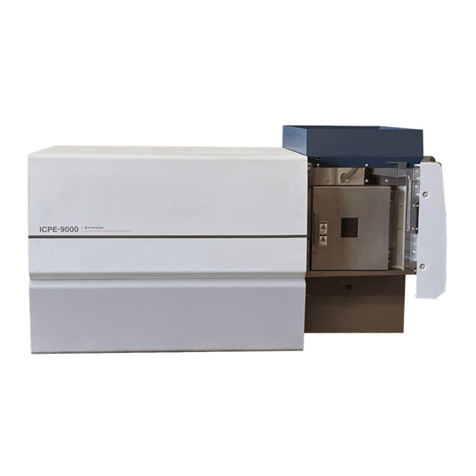
Shimadzu
Shimadzu ICPE-9000 instruction manual

MELAG
MELAG Careclave 618 Technical manual

Goobay
Goobay 20319 user manual
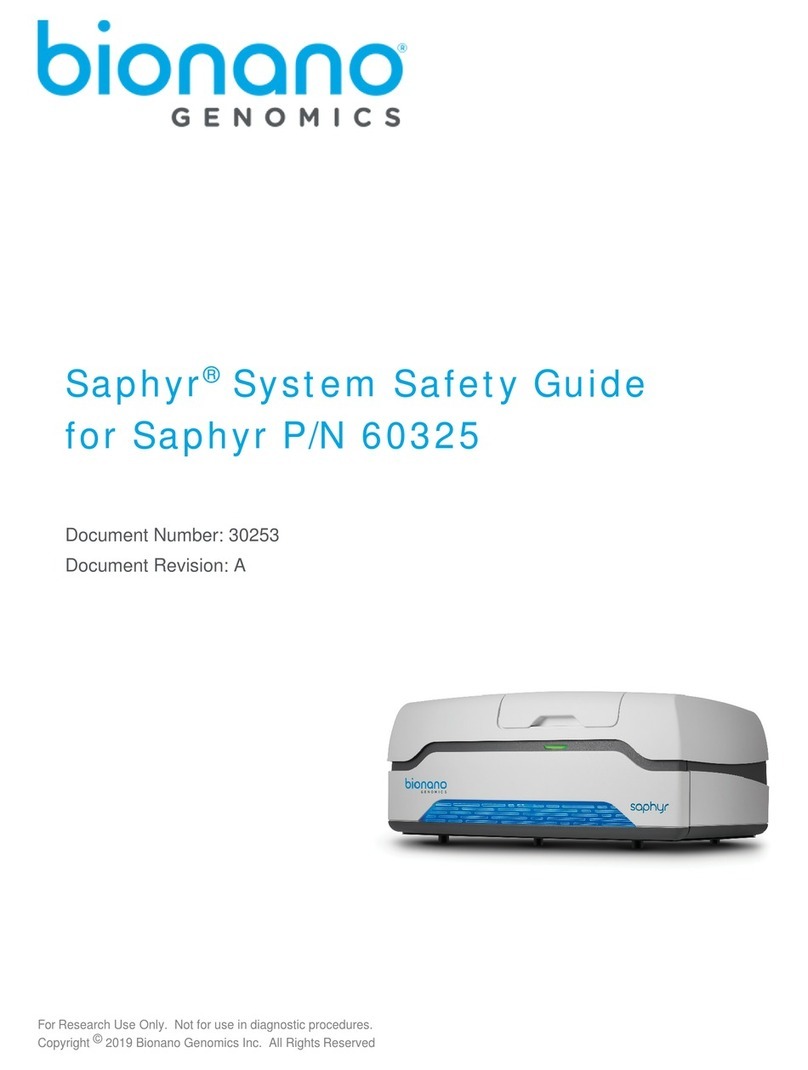
BioNano Genomics
BioNano Genomics Saphyr System System Safety Guide

Thermo Scientific
Thermo Scientific STP420D instruction manual
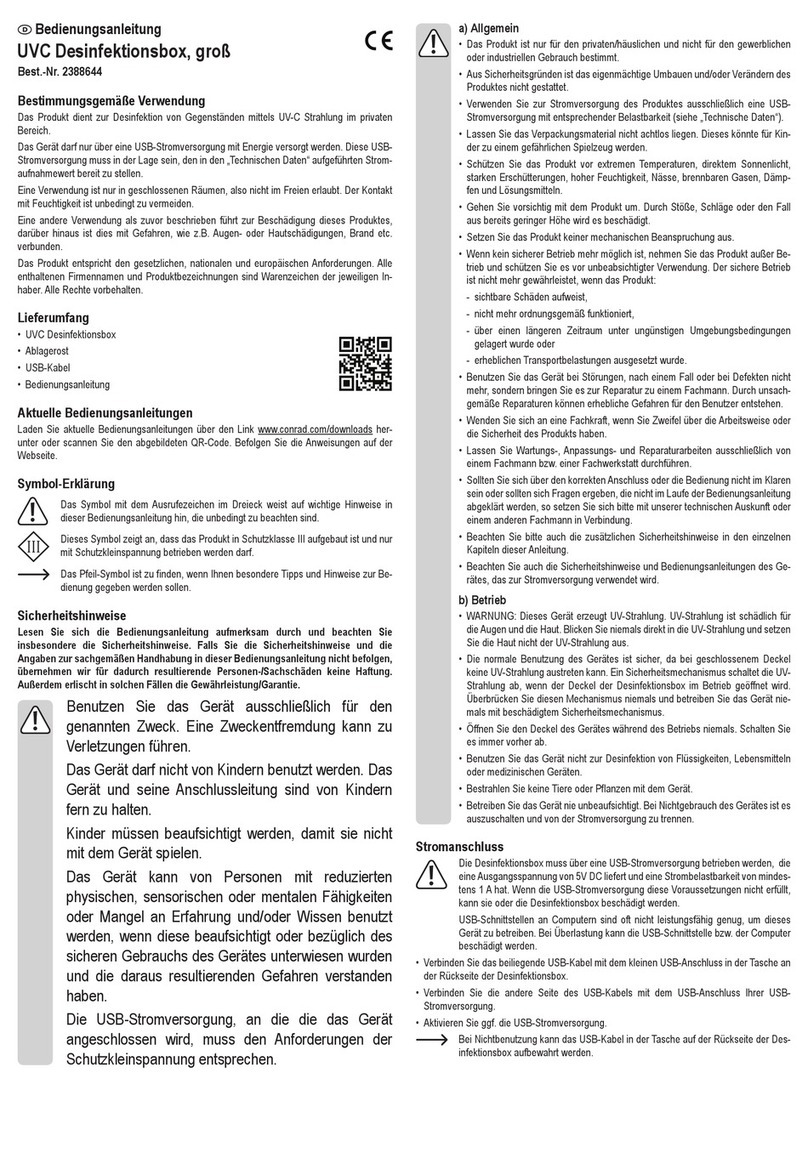
Conrad
Conrad LUM-U260S-01 operating instructions
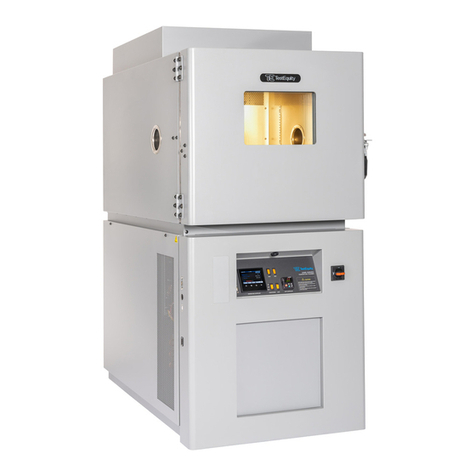
TestEquity
TestEquity 1007H Operation and service manual
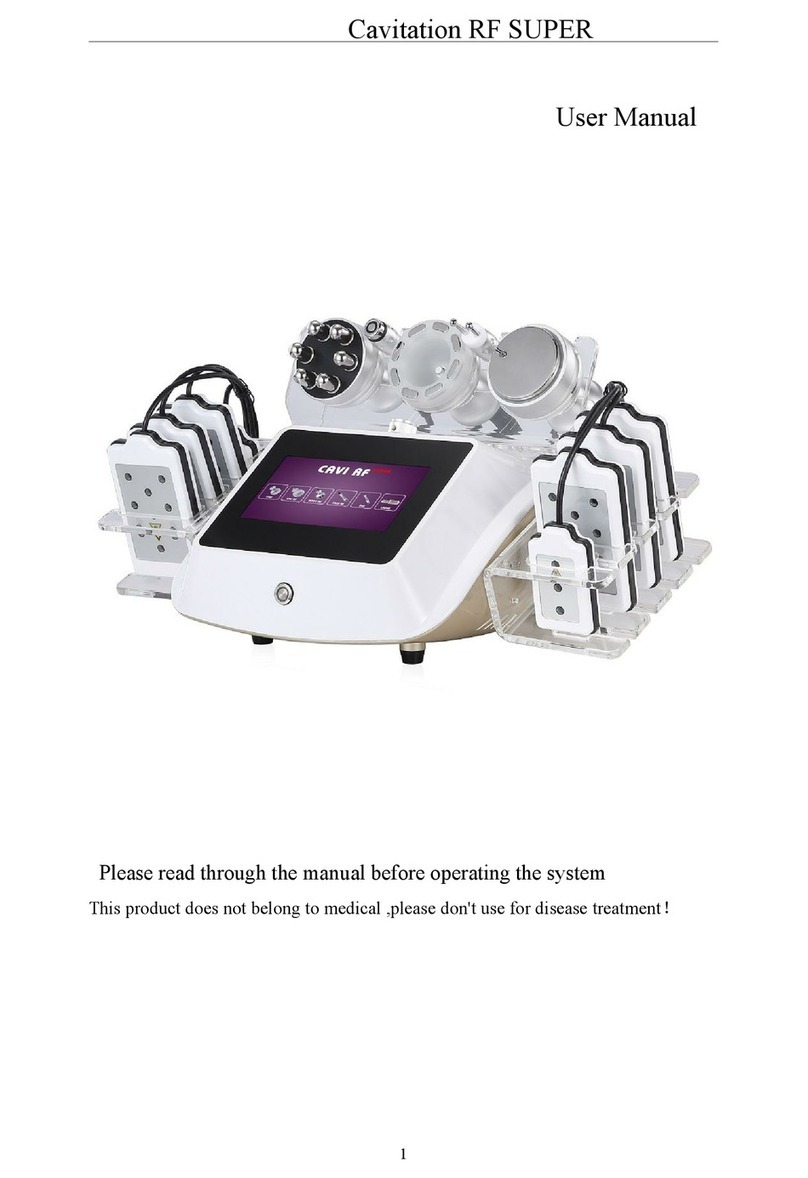
cavitation
cavitation RF SUPER user manual

Fisher Scientific
Fisher Scientific Fisherbrand Isotemp FBG Series Installation and operations
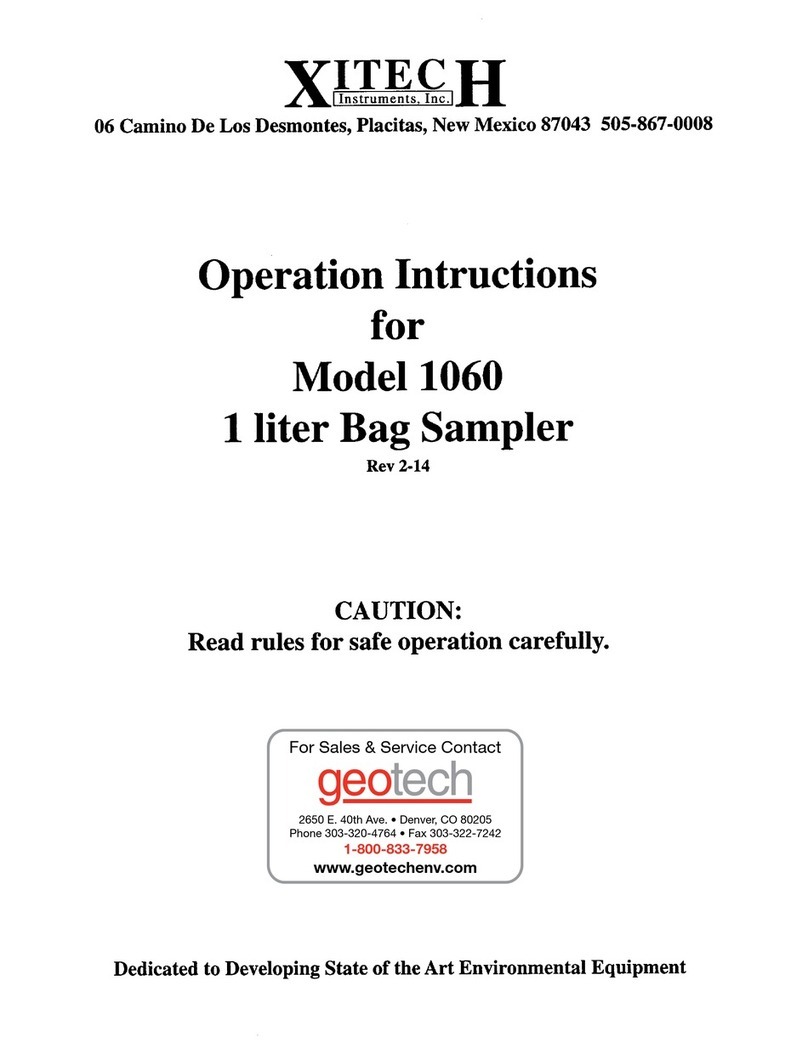
Xiitech
Xiitech 1060 Operation Intructions

Leica
Leica CM1520 Instructions for use
